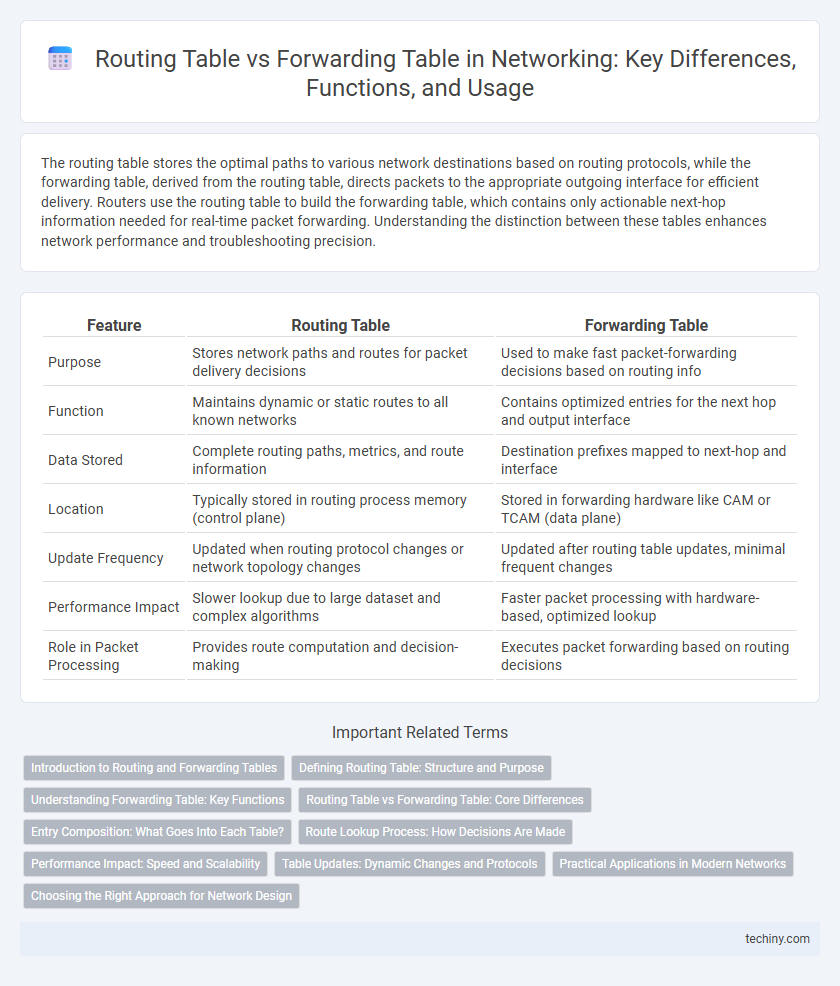The routing table stores the optimal paths to various network destinations based on routing protocols, while the forwarding table, derived from the routing table, directs packets to the appropriate outgoing interface for efficient delivery. Routers use the routing table to build the forwarding table, which contains only actionable next-hop information needed for real-time packet forwarding. Understanding the distinction between these tables enhances network performance and troubleshooting precision.
Table of Comparison
| Feature | Routing Table | Forwarding Table |
|---|---|---|
| Purpose | Stores network paths and routes for packet delivery decisions | Used to make fast packet-forwarding decisions based on routing info |
| Function | Maintains dynamic or static routes to all known networks | Contains optimized entries for the next hop and output interface |
| Data Stored | Complete routing paths, metrics, and route information | Destination prefixes mapped to next-hop and interface |
| Location | Typically stored in routing process memory (control plane) | Stored in forwarding hardware like CAM or TCAM (data plane) |
| Update Frequency | Updated when routing protocol changes or network topology changes | Updated after routing table updates, minimal frequent changes |
| Performance Impact | Slower lookup due to large dataset and complex algorithms | Faster packet processing with hardware-based, optimized lookup |
| Role in Packet Processing | Provides route computation and decision-making | Executes packet forwarding based on routing decisions |
Introduction to Routing and Forwarding Tables
Routing tables store network paths and metrics to determine the best possible route for data packets across different networks. Forwarding tables, derived from routing tables, are optimized for rapid packet delivery by matching destination addresses to specific output interfaces. Efficient routing and forwarding tables are essential for minimizing latency and maximizing network throughput in complex communication systems.
Defining Routing Table: Structure and Purpose
A routing table is a data structure used by routers to determine the best path for packet forwarding based on network topology and routing protocols. It contains a list of destination IP addresses, associated subnet masks, next-hop addresses, and interface information essential for route selection. This structure enables efficient network traffic management by guiding routers in choosing optimal paths to reach target networks.
Understanding Forwarding Table: Key Functions
The forwarding table stores destination addresses and corresponding output interfaces, enabling routers to efficiently direct packets to their next hop. It operates at the data link layer, using MAC addresses and interface information for rapid packet forwarding. Unlike the routing table, which maintains broader network path information, the forwarding table is optimized for speed and immediate lookup during the packet forwarding process.
Routing Table vs Forwarding Table: Core Differences
Routing tables store the best paths to various network destinations based on routing protocols, containing multiple possible routes evaluated by metrics such as hop count and bandwidth. Forwarding tables, derived from routing tables, contain optimized entries used by routers to make real-time packet forwarding decisions with minimal lookup time. The core difference lies in routing tables managing path selection and network topology knowledge, while forwarding tables handle efficient packet delivery at the data plane level.
Entry Composition: What Goes Into Each Table?
Routing tables contain comprehensive entries including destination networks, subnet masks, next-hop addresses, route metrics, and routing protocols used, enabling routers to determine the best path for packet propagation. Forwarding tables, derived from routing tables through processes like route aggregation and filtering, consist primarily of destination IP prefixes and corresponding output interfaces or next-hop addresses to facilitate efficient packet forwarding decisions. The routing table serves as a broader routing knowledge base, whereas the forwarding table optimizes rapid data plane lookups for packet transmission.
Route Lookup Process: How Decisions Are Made
The routing table stores the complete network topology and determines the best path for packet delivery based on metrics such as hop count or bandwidth, while the forwarding table contains simplified, optimized entries used for rapid packet forwarding. During the route lookup process, the router consults the forwarding table to quickly match the destination IP address against prefixes using longest prefix match algorithms, ensuring efficient packet routing. This separation between the routing table's comprehensive path calculation and the forwarding table's streamlined decision-making enhances overall network performance and scalability.
Performance Impact: Speed and Scalability
Routing tables store comprehensive network topology information and require complex lookup processes, which can slow down packet forwarding as network size grows. Forwarding tables, optimized for speed, use simplified, precomputed routes that enable rapid packet forwarding and improve scalability in high-traffic environments. The separation of routing and forwarding functions enhances overall network performance by balancing detailed path computation with efficient data plane operations.
Table Updates: Dynamic Changes and Protocols
Routing tables rely on dynamic updates from routing protocols like OSPF, BGP, and RIP to reflect network topology changes, ensuring accurate path selection. Forwarding tables, derived from routing tables, update more frequently to optimize packet switching at the data plane level, using information such as IP prefixes and next-hop addresses. Protocols trigger incremental or full routing table updates, directly influencing the forwarding table's entries and maintaining efficient traffic forwarding.
Practical Applications in Modern Networks
Routing tables store the complete path information for data packets across various networks, enabling routers to determine the optimal route based on network topology changes and policies. Forwarding tables, derived from routing tables, contain simplified, next-hop data essential for the rapid packet-switching process within individual routers, ensuring low-latency data transmission. Modern network devices leverage this separation to optimize performance in large-scale environments like data centers and ISPs, enhancing scalability and real-time traffic management.
Choosing the Right Approach for Network Design
Routing tables store the best paths to various network destinations based on routing protocols and metrics, while forwarding tables contain the actual next-hop information used to direct packets. Choosing the right approach for network design involves balancing the complexity of dynamic routing calculations with the efficiency of fast packet forwarding. Optimizing this balance improves network scalability, reduces latency, and enhances overall performance.
routing table vs forwarding table Infographic

 techiny.com
techiny.com